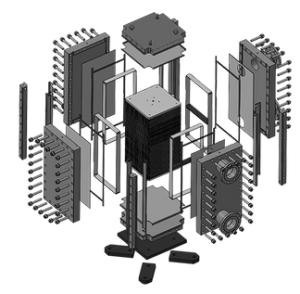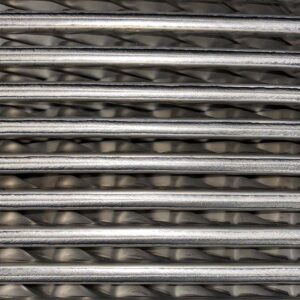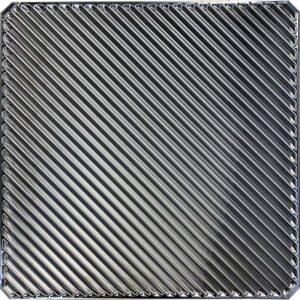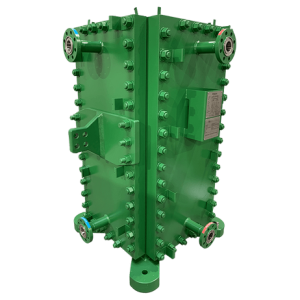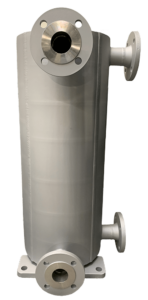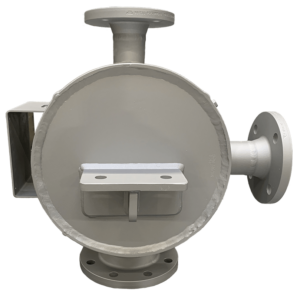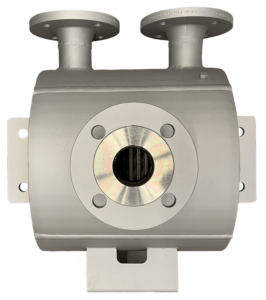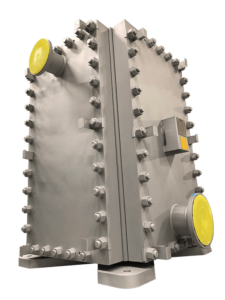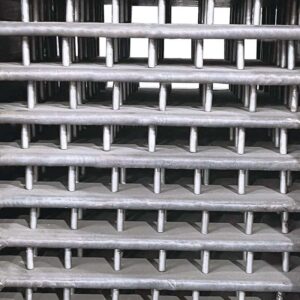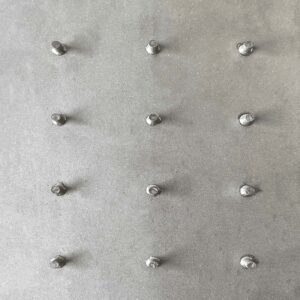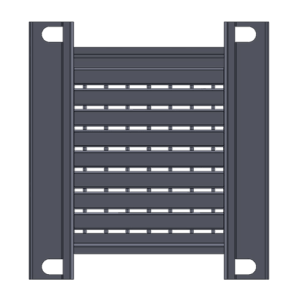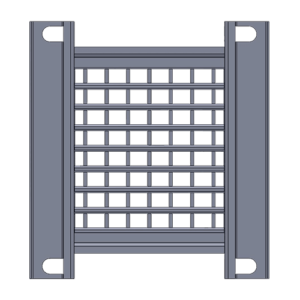Welded Plate Heat Exchangers
Welded Plate Heat Exchangers
Welded Plate Heat Exchangers are a type of heat exchanger used in industrial process applications, often for semi-fouling or viscous media or when temperature or pressure is higher than technically possible for Gasketed Plate types. Most often corrugated plates are used and these are welded together creating a multi-channel passage for the media. The media, separated by the plates, normally flow in cross flow / counter current (when more than one pass is used).
Below description of the following types of Welded Plate Heat Exchangers that we can provide:
- Welded Plate Heat Exchangers with Corrugated Plates mounted in a frame with bolted side panels forming a block shape – GreanBoxTM – Model S
- Fully Welded Plate Heat Exchangers with Corrugated Plates mounted in a fully welded frame with semi-shell side panels forming a cylindrical block shape – GreanBoxTM – Model W
- Welded Plate Heat Exchangers with Studded Plates mounted in a frame with bolted side panels forming a block shape – GreanBoxTM – Model SP
- Welded Plate Heat Exchangers with Corrugated Plates mounted in a frame and inserted in a shell with a bolted side panel on one side forming a cylindrical shape – Plate and Shell Heat exchanger
GreenBoxTM – Model S
GreenBoxTM – model S, is a welded heat exchanger, made of square corrugated plates welded together, forming the heart of the heat exchanger. There is no gasket between the plates; the sealing is done by welding. Only the removable side panels have gaskets for external sealing.
The heart, plate surface area, of the heat exchanger is accessible for inspection or cleaning by simply removing the 4 side panels.
The patented soft corners design of the heart/panels assembly of the GreenBox makes this heat exchanger the most robust and reliable of its category. Due to its mechanical reliability, is the ideal solution for operation in tough process duties with high pressures and temperatures.
Nexson Welded Plate Heat Exchangers are a concentrate of thermal efficiency for heat recovery interchanger, condenser, reboiler or evaporator applications and can be used in semi-fouling duties.
The high turbulent flow induced by the corrugated plates of GreenBox makes it about 5 times more thermally efficient than a traditional shell & tube heat exchanger. It also allows a temperature approach of approximately 2°C. A better heat transfer coefficient means also a compact size of Greenbox and this can also reduce significantly installation, operation and maintenance costs.
The GreenBox operates in single or multi-pass configuration and, if needed, access to the plates for inspections and cleaning is given by simply removing the side panels.
Advantages:
Robust and Patented
Robustness and reliability for the welded plate heat exchanger is a key feature. Nexson has patented his own welded plate heat exchanger, named GreenBox ™. With proven pressure and temperature cycling tests, this type of heat exchanger is one step ahead of the competition in terms of robustness.
2 Semi-Fouling Medias
This welded plate heat exchanger is designed to handle one or two semi-fouling media at the same time. Fouling handling is done thanks to corrugated plates which offer high shear stress values on the wall surface.
Easy To Clean
Thanks to dismountable panels, the welded heat exchanger is easy to clean with a high-pressure water jet.
Interchangeable “Heart” / Heat Transfert Area
Due to its modular construction, it is possible to take out the heat transfer area from panels and substitute it while keeping the existing panels.
In case of raw material requirement change due to process evolution, a long-term operation approach is possible for this heat exchanger technology. It is even possible to substitute a solution initially designed for corrugated plates with a heart with Nexson studded plates, for more fouling media.
Close Temperature Approach
Thanks to the corrugated plates, combined with a high K value, it is possible to reach a very close temperature approach and even get crossing temperatures.
High-Volume Flow with Small Pressure Drops
The Green box welded plate heat exchanger is a multiple cross-section heat exchanger that allows different baffle arrangements according to the duty and pressure drop limitation required.
Full Inspection of The Heat Transfer Area
By removing the 4 panels you can access the whole heat transfer area for inspection during periodical plant shutdown.
Material Selection and Design Limits
GreenBox Welded Heat Exchangers, Models S and W can be manufactured in any material that can be formed, to corrugated plates, and welded such as:
- 304 / 304L, 316 / 316L, 904L,
- 254 SMO, C276, Nickel 200/201, Alloy 59
- Titanium Gr1, Titanium Gr11
- Other upon request
Nexson GreenBox is used for design pressures:
- from full vacuum to 50 barg,
and design Temperatures:
- from – 50°C design temperature to 450°C.
GreenBoxTM – Model W
GreenBoxTM – model W is a variation of the GreenBoxTM – model S but in this case, we have a truly fully welded heat exchanger. As before the heat exchanger is made of square corrugated plates welded together, forming the heart of the heat exchanger. There is no gasket between the plates; the sealing is done by welding. For this model, instead of the removable side panels with gaskets for external sealing, we have 4 semi-shells welded to the plate-pack and closing it completely in a cylindrical shape. As we now have a fully welded and non-openable construction this model is perfect for clean media at high temperatures and/or pressures. As the GreenBoxTM – model W is fully welded no gaskets are needed nor bolts for closing panels at specific torques. This, in combination with Nexson’s patented and robust corner construction, ensures that leakage problems are next to nonexistent, even for applications with periodical operation.
Other than that, the Applications (below), Advantages, Material Selection and Design Limits (above) for the GreenBoxTM – model W are similar to the GreenBoxTM – model S.
GreenBoxTM – Model SP
GreenBoxTM – model SP is another variation of the GreenBoxTM – model S. In some applications, the small channel spacing of the welded plate heat exchangers with corrugated plates is a limitation, especially for fouling media. To solve this problem Nexson is presenting another patented solution with flat studded plates, similar to what is used in Spiral Heat Exchangers, welded together in a plate pack (heart) similar to the corrugated plate solutions mentioned above.
With this ingenious solution the stud length and thus the channel spacing can be individually set for both media sides, allowing more flexibility in design when there is a considerable difference in flow rates between hot and cold side media. Large channel spacing also allows for applications with fouling media.
As for the GreenBoxTM – model S the plate pack is installed in a frame with four side panels. By removal of these side panels inspection of the heat exchanger area can be made and mechanical cleaning by hydro jet be performed.
A limitation to the previous models of heat exchangers is that the plates have to be molded, corrugated, thus not allowing the use of certain materials. With the GreenBoxTM – model SP using flat plates the plate thickness normally will be larger, thus more robust and allowing for application with erosive media. Flat plates also provide the possibility to use less moldable materials, such as Duplex and Super Duplex with superior corrosion resistance.
Other than that, the Applications (below) and Advantages (below) for the GreenBoxTM – model SP are similar to the GreenBoxTM – model S.
Material Selection and Design Limits
GreenBox Welded Heat Exchangers, Models SP can be manufactured in any material that can be welded, to studded plates, such as:
- 304 / 304L, 316 / 316L, 904L,
- 254 SMO, C276, Nickel 200/201, Alloy 59
- Titanium Gr1, Titanium Gr11
- Duplex Steel, Superduplex Steel
- Carbon Steel SA 516 Gr 60/70
- Other upon request
Nexson GreenBox is used for design pressures:
- from full vacuum to 50 barg,
and design Temperatures:
- from – 50°C design temperature to 450°C.
Plate & Shell Heat Exchangers
Nexson group can also provide Plate & Shell Heat Exchangers where Nexson Corrugated Welded Plate Placks are inserted into cylindrical Shells with an openable panel on one side. The plate pack can be welded into place or inserted with gaskets for sealing between the hot and cold sides. For the later solution, the plate pack is removable for mechanical cleaning or even substitution.
Applications for Welded Plate Heat Exchangers
Liquid-to-Liquid Applications
Welded Plate Heat Exchangers for liquid-to-liquid applications are used in most industries: – Pulp and Paper, Refineries; – Petrochemicals; – Oil&Gas;- Food Industries; – Mining; – Steel and Metal manufacturing, etc. in applications for:
- Heat Recovery
- Heating
- Cooling
Bi-Phasic Applications
Condensation with Sub-cooling
After the condensing phase, with baffles arrangement, a heat area surface can be dedicated where you may want to get the condensate subcooled before exiting the unit.
Evaporation / Reboiler
The green box welded plate heat exchanger can be applied as heat exchanger thermosyphon reboiler/evaporator. Reboiling/Evaporation is always in a single-pass configuration.
Traditional uses
Welded Plate Heat Exchangers for bi-phasic applications are used in most industries: – Pulp and Paper, Refineries; – Petrochemicals; – Oil&Gas;- Food Industries; – Mining; – Steel and Metal manufacturing, etc. in
Welded Plate Heat Exchangers in Industry
Welded Plate heat exchangers are used in many different industrial applications due to their efficient and reliable heat transfer capabilities. Their flexibility and ability to handle different liquids, semi-fouling or high viscous media, as well as gases or bi-phasic media, make them useful in many fields and applications. The Welded Plate Heat Exchangers are often used as economizers, heaters/coolers, or in two-phase applications such as condensing or evaporation operations, steam heaters, reboilers, etc.
Below are some Industries and applications where Welded Plate Heat Exchangers can be applied with great success:
In the Oil & Gas industry, Onshore and Offshore, several Heat Exchanger positions can be handled efficiently by Welded Plate Heat Exchangers. Often Welded Plate Heat Exchangers can replace positions where Shell & Tube or Gasketed Plate Heat Exchangers are traditionally used.
In Petroleum Refineries petroleum is transformed and refined into useful products such as gasoline, diesel fuel, fuel oils, heating oil, kerosene, liquefied petroleum gas and petroleum naphtha.
Petroleum Refining, being of fossil origin has opportunities for blending with fossil-free fuels, BioFuels, and research for new process routes for fossil-free feedstocks, such as new bio-oil feeds.
Refining petroleum requires several process steps such as: – Desalting; – Atmospheric and Vacuum Distillation; – Catalytic Cracking; – Reforming; – Blending, etc. These need heat exchangers for efficient energy use.
An enormous amount of chemicals of various types are being made from petroleum derivates for industrial use and consumer goods that require a wide range of different unit operations. Some of the most common petrochemicals manufactured worldwide are PVC and Vinilchloride, PolyEthylen, PolyAmides, Ethylene Glycol and PolyEsters, PolyStyrene, Therphtalic Acid and PET, TDI (Toulene Diisocyante), MDI (Methylene Diphenyl Diisocyanate), etc.
With the ongoing energy changes from traditional fossil-based energy and fuel to the electrification of processes and vehicles the mining industry will be affected as more minerals will be necessary for batteries etc. Global warming and new more sustainable mining and mineral upgrading processes are being developed to reduce carbon footprint. Also, for the steel industry new processes are being researched to eliminate carbon-intensive coke oven gas and reduce iron by Direct Reduction Process with H2 gas as a reduction agent.
The traditional production process, with coke oven gas, is likely to be used for many years in most parts of the world. These facilities need upgrades for better energy effectiveness, lower emissions, and have huge opportunities for Carbon Capture and carbon capture utilization.
An enormous amount of chemicals of various types are being made for industrial use and consumer goods that require a wide range of different unit operations and heat transfer. Some of the most common chemicals manufactured in the world are Sulphuric Acid, Phosphoric Acid, Sodium Hydroxide, Chlorine, Chloridric Acid, Ammonia, Peroxide, Formol and Formic Acid, Inks and Pigments such as Titanium Dioxide, etc.
Many of these chemicals are produced through paths that benefit from the use of Welded Plate Heat Exchanges.
As for many other Industries also the traditional Pulp and Paper Industry is looking for improvements and how to make better use of potentially valuable side products such as: – BioFuels from Tall Oil; – Methanol production; – Lignin separation from black liquor; – Turpentine; – Sulphuric Acid from off-gas; – BioGas and BioPellets; – New BioChemicals; etc. Many Pulp mills, using the Kraft (sulfate) process, are also self-sufficient in energy, export electricity to the grid and provide district heating to nearby cities. Modern Pulp Mills also have the potential for a Negative Carbon footprint with the use of Carbon Capture and Storage or Utilization. New concepts are created, and these new mills are often called BioPruduct Mills.
Welded Plate Heat Exchangers are also widely used in different Pulp and Paper Industry Applications.
Growing populations increase the challenges of providing raw materials, processing and transporting food to consumers. Erivac can provide process equipment for a large range of food industries, such as: – Dairy Products, milk and milk proteins; – Breweries; – Fruit Juices; – Starch and vegetable proteins; – Sugar and Alcohol industries; – Edible Oils and Fats; – Soups and Sauces etc. In many cases, Wastewater from Food Industries also has high organic loads making it ideal for BioGas Generation.
The Welded Plate Heat Exchangers provide a compact structure and enable efficient heat transfer, making them ideal for high-efficiency heating/cooling solutions. Their ability to handle high pressures and temperatures, as well as different viscosities, semi-fouling media or even fouling and erosive media for the studded plate model, and corrosive media, makes them an important part of many industrial processes where heat transfer and temperature control are crucial.

